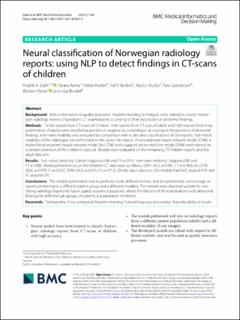| dc.contributor.author | Dahl, Fredrik Andreas | |
| dc.contributor.author | Kasicheyanula, Taraka Rama | |
| dc.contributor.author | Hurlen, Petter | |
| dc.contributor.author | Brekke, Pål Haugar | |
| dc.contributor.author | Husby, Haldor | |
| dc.contributor.author | Gundersen, Tore | |
| dc.contributor.author | Nytrø, Øystein | |
| dc.contributor.author | Øvrelid, Lilja | |
| dc.date.accessioned | 2022-04-20T07:35:35Z | |
| dc.date.available | 2022-04-20T07:35:35Z | |
| dc.date.created | 2021-04-20T13:48:03Z | |
| dc.date.issued | 2021 | |
| dc.identifier.citation | BMC Medical Informatics and Decision Making. 2021, 21 (1), 1-8. | en_US |
| dc.identifier.issn | 1472-6947 | |
| dc.identifier.uri | https://hdl.handle.net/11250/2991484 | |
| dc.description.abstract | Background
With a motivation of quality assurance, machine learning techniques were trained to classify Norwegian radiology reports of paediatric CT examinations according to their description of abnormal findings.
Methods
13.506 reports from CT-scans of children, 1000 reports from CT scan of adults and 1000 reports from X-ray examination of adults were classified as positive or negative by a radiologist, according to the presence of abnormal findings. Inter-rater reliability was evaluated by comparison with a clinician’s classifications of 500 reports. Test–retest reliability of the radiologist was performed on the same 500 reports. A convolutional neural network model (CNN), a bidirectional recurrent neural network model (bi-LSTM) and a support vector machine model (SVM) were trained on a random selection of the children’s data set. Models were evaluated on the remaining CT-children reports and the adult data sets.
Results
Test–retest reliability: Cohen’s Kappa = 0.86 and F1 = 0.919. Inter-rater reliability: Kappa = 0.80 and F1 = 0.885. Model performances on the Children-CT data were as follows. CNN: (AUC = 0.981, F1 = 0.930), bi-LSTM: (AUC = 0.978, F1 = 0.927), SVM: (AUC = 0.975, F1 = 0.912). On the adult data sets, the models had AUC around 0.95 and F1 around 0.91.
Conclusions
The models performed close to perfectly on its defined domain, and also performed convincingly on reports pertaining to a different patient group and a different modality. The models were deemed suitable for classifying radiology reports for future quality assurance purposes, where the fraction of the examinations with abnormal findings for different sub-groups of patients is a parameter of interest. | en_US |
| dc.language.iso | eng | en_US |
| dc.publisher | BMC | en_US |
| dc.rights | Navngivelse 4.0 Internasjonal | * |
| dc.rights.uri | http://creativecommons.org/licenses/by/4.0/deed.no | * |
| dc.title | Neural classification of Norwegian radiology reports: using NLP to detect findings in CT-scans of children | en_US |
| dc.type | Peer reviewed | en_US |
| dc.type | Journal article | en_US |
| dc.description.version | publishedVersion | en_US |
| dc.source.pagenumber | 1-8 | en_US |
| dc.source.volume | 21 | en_US |
| dc.source.journal | BMC Medical Informatics and Decision Making | en_US |
| dc.source.issue | 1 | en_US |
| dc.identifier.doi | 10.1186/s12911-021-01451-8 | |
| dc.identifier.cristin | 1905329 | |
| dc.relation.project | Norges forskningsråd: 269887 | en_US |
| cristin.ispublished | true | |
| cristin.fulltext | original | |
| cristin.qualitycode | 1 | |

